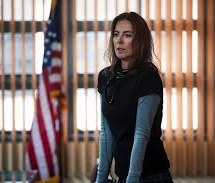A Teachable Moment
Depicting Torture Has Its Risks: Zero Dark Thirty
Posted by Jennine Lanouette on Wednesday, February 20th, 2013
 Kathryn Bigelow has certainly been on the hot seat lately. People don’t seem to understand Zero Dark Thirty the way she intended it to be understood. Having been publicly taken to task back in December by Senators Dianne Feinstein, John McCain and Carl Levin for appearing to claim in her film that torture played an important role in the hunt for Osama Bin Laden, she has been on the defense ever since. With the eagle eye of such government heavyweights staring down at her, it was heartening to see her professional community offer a warm embrace the other night with the Writer’s Guild Award for Best Original Screenplay given to the film’s writer Mark Boal.
Kathryn Bigelow has certainly been on the hot seat lately. People don’t seem to understand Zero Dark Thirty the way she intended it to be understood. Having been publicly taken to task back in December by Senators Dianne Feinstein, John McCain and Carl Levin for appearing to claim in her film that torture played an important role in the hunt for Osama Bin Laden, she has been on the defense ever since. With the eagle eye of such government heavyweights staring down at her, it was heartening to see her professional community offer a warm embrace the other night with the Writer’s Guild Award for Best Original Screenplay given to the film’s writer Mark Boal.
The tide began to turn in support of Bigelow after she made a public statement in the L.A. Times on January 15th. “Confusing depiction with endorsement,” she wrote, “is the first step toward chilling any American artist’s ability and right to shine a light on dark deeds, especially when those deeds are cloaked in layers of secrecy and government obfuscation.” I, for one, was relieved to learn that it was not her intention to give an “endorsement” of torture in her film, but rather to simply provide a “depiction.”
Nonetheless, I have come to suspect that the key word in this sentence is “confusing.” While the artist’s right to free expression must always be protected and defended, when handling such a disturbing subject as torture, the artist also has a responsibility to communicate clearly enough that people will be able to take in her intended point. In the case of Zero Dark Thirty, I can’t help feeling that the degree to which viewers confused the depiction with endorsement was not so much a matter of careless interpretation as it was a result of the particular way that Bigelow and Boal put forth the story.
Torture scenes are certainly not new. But the first thing I notice when considering other examples is that the vast majority of such depictions are presented from the point of view of the victim. The next thing I notice is that in these scenes often the severity is actually much harsher.  I’m thinking of Casino Royale when Daniel Craig’s James Bond is sat naked in a chair with the seat cut out to expose his genitals and then assaulted with a knotted rope from below. Braveheart also comes to mind when Mel Gibson’s William Wallace suffers his intestines being disgorged before his execution.
I’m thinking of Casino Royale when Daniel Craig’s James Bond is sat naked in a chair with the seat cut out to expose his genitals and then assaulted with a knotted rope from below. Braveheart also comes to mind when Mel Gibson’s William Wallace suffers his intestines being disgorged before his execution.
When we witness torture in sympathy with the victim, we are able to feel the superiority of the character who endures without breaking. Although being victimized, these guys are not acting like victims. As a result, we are comforted that, in the same position, maybe we would do the right thing as well. We are also comforted on a metaphoric level, since we have all felt a little tortured by life itself at one time or another. We take inspiration that we can similarly hold up under our own lesser hardships. Thus, it helps that we are seeing it in the context of a fictionalized story. We are aware that it is a fabricated adventure designed to entertain us, or a made-up version of a distant, more barbarous, past.
Although being victimized, these guys are not acting like victims. As a result, we are comforted that, in the same position, maybe we would do the right thing as well. We are also comforted on a metaphoric level, since we have all felt a little tortured by life itself at one time or another. We take inspiration that we can similarly hold up under our own lesser hardships. Thus, it helps that we are seeing it in the context of a fictionalized story. We are aware that it is a fabricated adventure designed to entertain us, or a made-up version of a distant, more barbarous, past.
The only precedent I can think of from the perpetrator’s point of view is in The Girl With the Dragon Tattoo when Lisbeth Salander tortures her state-appointed guardian after he has tied her up and raped her. Obviously, in this case she is both victim and perpetrator. We are getting vicarious (and metaphoric) retribution against the original  perpetrator along with her. In Zero Dark Thirty, there is too much distance between the original perpetrator of the 9/11 attacks and this lowly follower being abused in front of us to provide any vicarious satisfaction. More to the point, we are too aware that this torture scene exists in the context of a true story for it to satisfy on a metaphoric level.
perpetrator along with her. In Zero Dark Thirty, there is too much distance between the original perpetrator of the 9/11 attacks and this lowly follower being abused in front of us to provide any vicarious satisfaction. More to the point, we are too aware that this torture scene exists in the context of a true story for it to satisfy on a metaphoric level.
Given how much more difficult it is to witness a torture scene that is purportedly true and given to us from the perpetrator’s point of view, the choice of Bigelow and Boal to undertake such a topic is a daring move. Their motivation may well have been to not shy away from an awful truth. They may have wanted to put it out there plainly for all to see in the hope that, presented with an unvarnished account, people will come around to the moral high ground. That, instead, some people read Bigelow’s depiction as endorsement and became outraged at her is simply an indication of the mixed messages that, unintentionally, got built into the story.
When we enter a film viewing experience, our first engagement is to unconsciously seek out someone to identify with. This is partly a conditioned response we’ve been taught by all the other films we’ve seen. But we also have a hard-wired mechanism in our perceptive faculties that wants to attach to a single main character and experience the events through his or her eyes. This mechanism is programmed to attach to the first character we meet who is at a power disadvantage. In other words, we can’t help but get attached to the underdog.
In the opening scene of Zero Dark Thirty, we consciously want to attach to Jessica Chastain’s Maya. She’s female, she’s pretty, she’s American, she’s well dressed. We know the film is about  her because we’ve seen the previews and the publicity. But, we also can’t avoid feeling what the torture victim in the scene is going through. So we’re confused. To identify with Maya we have to do a cognitive override of our feelings about the victim. For many viewers, the override fails and we come to see Maya as the perpetrator of torture. Her occasional winces are not enough to make her sympathetic when we are also being confronted with the victim’s screams. We also notice that, despite her wincing, overall she seems to be okay with it. This tells us that, in order to go with her in her story, we’re being expected to numb out our feelings about the torture and be okay with it, too.
her because we’ve seen the previews and the publicity. But, we also can’t avoid feeling what the torture victim in the scene is going through. So we’re confused. To identify with Maya we have to do a cognitive override of our feelings about the victim. For many viewers, the override fails and we come to see Maya as the perpetrator of torture. Her occasional winces are not enough to make her sympathetic when we are also being confronted with the victim’s screams. We also notice that, despite her wincing, overall she seems to be okay with it. This tells us that, in order to go with her in her story, we’re being expected to numb out our feelings about the torture and be okay with it, too.
We are not helped in all this by the lack of information we are given about Maya before being thrown into the torture pit with her. We don’t know, for example, who she is, who she’s working for, what her position is, how she got there, what she’s interested in, what her values are, where her passions lie. We start to piece all this together in the subsequent scenes. But a film’s main character not only gives us someone to attach to but also usually embodies the point of view of the film’s creators. Given the disturbing nature of torture, along with the risks of showing it from the perpetrator’s point of view, for Bigelow and Boal to jump into it without first orienting us to their main character, and, thus, the value system of the film, only puts them further out on a limb.
In fact, we are introduced to the torture even before we are introduced to Maya, which may be the greatest source of audience confusion. It is somewhat fundamental to screenwriting that the order in which you present your information has everything to do with how it is perceived. By putting a piece of information first, you are telling the viewer that this is the most important thing they need to know. The audience for Zero Dark Thirty, upon entering this film, is primed with an expectation that they will find out how Osama Bin Laden was tracked down and, ultimately, killed. By opening the film with torture, Bigelow is signaling to the audience, whether she intended to or not, that this was the most important factor in that hunt.
If Bigelow wanted to make absolutely sure viewers didn’t mistake her depiction for endorsement, she would have done better to place the torture a few scenes later in the story, assign it to a secondary character and have the abusive interrogation techniques lead down a rabbit hole of unusable and misleading information. From this we would have learned that torture was only one among many information-gathering tactics, it is not endorsed by the film’s creators and, furthermore, it doesn’t work.
My guess is instead she went for the shock value of putting it front and center, telling herself she was providing a neutral depiction and audience members would decide for themselves. But I’m not sure it’s even possible to simply depict torture, especially when presenting it from the perpetrator’s point of view. I suspect any representation that does not condemn is bound to come across as endorsement. Just as standing silently behind a schoolyard bully as he beats up another child amounts to tacit acceptance of that behavior.
The rest of the film then does little to counter our first impression. In fact, it rather does the opposite. When Maya begins an interrogation of a key Al Qaeda financier, he says, “I have no wish to be tortured again. Ask me a question. I will answer it.” The implication here being that torture does work. After we see President Obama on television promising to put a stop to torture, Maya and her cohorts are forced to change tactics. They try to buy (for $25 million) the loyalties of a Jordanian doctor purported to have access to Bin Laden, but that effort results in a suicide bombing, killing several agents. We, thus, get the message that the alternative methods they must resort to are both expensive and deadly.
Maya and her fellow agents finally put their nose to the grindstone with the more painstaking methods of information gathering and analysis, but not without periodically bemoaning the loss of the detainee program. “Abu Graib and Gitmo fucked us,” says Counterterrorism Chief, The Wolf, to CIA officer Dan Stanton. “The detainee program is now fly paper.” In other words, if it hadn’t been for those guys blowing it, we would have a fountain of information at our disposal. Later, when George Wright, the CIA Pakistan Chief, is asked by the National Security Advisor for more proof that the compound houses Bin Laden, Wright says, “You know we lost our ability to prove that when we lost the detainee program. Who the hell am I supposed to ask?” Apparently, without the “enhanced” interrogation techniques, there’s no point in bothering to interrogate at all.
Again, I suppose it’s possible that Bigelow thought she was simply reporting, in a neutral manner, the pervasive attitudes within the CIA. But these are the film’s “good guys.” They are Maya’s fellow foot soldiers in the long march to finding and killing Osama Bin Laden. How can we not regard what they say as the point of view of the film? I’m not ascribing this point of view to Bigelow. I believe her when she says it was not her intention to endorse torture. I’m only looking at the elements she included in her film that might explain why others do.
I was curious to see this film because of what she and Boal did in The Hurt Locker. I greatly admired the unambiguous statement in that film, which opens with a quote from war correspondent Chris Hedges: “The rush of battle is a potent and often lethal addiction, for war is a drug.” And, in the end, leaves no doubt that its main character is hooked. Despite the right wing’s effort, in the rush of Oscar frenzy, to spin the film as a tribute to heroic sacrifice, any discerning viewer could see that, on the contrary, the film was laying bare a psychological trap endemic to the warrior life – the compulsion to seek more and more danger – which is a convenient ingredient for prosecuting ongoing war. This was a new idea to me. I had not considered war this way before.
Unfortunately, Zero Dark Thirty is not so clear. And, despite having seen it twice, taking a lot of notes and studying them ever since, I can’t find in it any such provocative new idea. The film appears to me as simply a dramatized reportage on how it all came down, except for this rather inflammatory element of torture, which, because of the way it is presented, has left a lot of people confused.
……………………………………………………………………………………………………………
You can watch Zero Dark Thirty on the following Video On Demand websites:
……………………………………………………………………………………………………………


